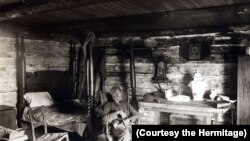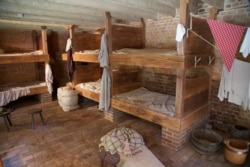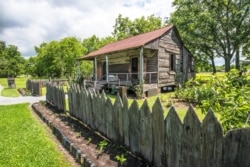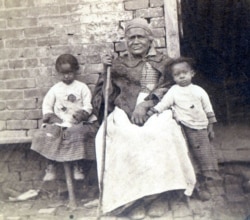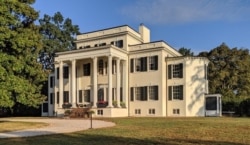Many tours on former plantations in the American South have focused on wealthy white landowning families and glossed over the people who were enslaved. This romanticized version centers on the lavish lifestyles and mansions of the slave owners while disregarding the enslaved people who built the homes and toiled in the fields.
While some plantation tours have intertwined the lives of the slavers and the enslaved, others are evolving as part of a growing awareness in the push for social justice that includes facing the enduring scars of slavery today.
Mount Vernon, the plantation owned by President George Washington in Alexandria, Virginia, has not shied away from talking about those scars.
During the Enslaved People of Mount Vernon Tour, history interpreter Jessica Obert tells stories, sometimes disturbing, about the men, women and children who were held in bondage.
Matt Briney, Mount Vernon's vice president of media and communications, told VOA the tour "brings humanity and sympathy to those who were enslaved."
Obert explains to a group that the word "enslaved" is used today rather than "slaves" because "enslaved" indicates it was forced on them.
"There has been a positive cultural shift in changing the word from 'slave' to 'enslaved,'" Briney said.
He thinks more people are interested in the enslaved tour in part because of Black Lives Matter protests. Those protests have gotten the attention of visitors, who are wanting to delve more into African American culture and gain a deeper understanding about enslavement, even if they find it unsettling, he said.
That was true for Jae Broderick of New York, who went on her first enslaved tour.
"The tour opened some uncomfortable truths and gave me a better understanding of the caste system of white society," she said. "The stories emphasized both the humanity and brutal realities of the people who were enslaved."
A former plantation called Laura, in Vacherie, Louisiana, also tells the personal stories of the people who were enslaved.
"As we discover new stories, we update our perspectives, including how Blacks and whites interacted with each other," Joseph Dunn, public relations director at Laura Plantation, told VOA.
He notes that in recent months, more people of color have been visiting Laura than in the past. He thinks "they may also want to know if their ancestors were enslaved on the plantation or learn about the history and struggles the people faced."
Other former plantations are also concerned about racial sensitivity.
That includes The Hermitage, the plantation home of President Andrew Jackson in Nashville, Tennessee, according to Howard Kittell, president and chief executive officer at The Hermitage.
"Even though we have continually woven the story of the enslaved people into the story of President Jackson, in the past five years, we have been more sensitive about how we convey the stories about enslavement," Kittell said.
But some plantations are sticking to their old narrative about the Old South.
Dunn, of Laura Plantation, said some tours in Louisiana, Alabama and Mississippi hark back to antebellum nostalgia, with stories about "the big house" with the wealthy white family. It's a more comfortable story to sell, he said, than the terrible history of enslavement.
That was the case at Oatlands Historic House and Gardens in Leesburg, Virginia, where tours highlighted the plantation's slave owners and neglected to mention the Black people who labored there.
Now that is about to change, said Caleb Schutz, CEO at Oatlands. "Upcoming tours will tell the entire truth about the people who were enslaved," he said, not a sanitized version about the mansion and white families, "which in a sense, memorializes the enslaver."
The details are being finalized by a new board of directors, which includes a white descendant of the enslavers and two African Americans, one of whom discovered that some of his ancestors had been enslaved on the plantation.
Oatlands is finally being held "accountable for enslavement," including that of my ancestors, Ryan Williams told VOA, "and needs to tell the unvarnished truth about the people who were held against their will to farm the land."
A tour of Oatlands isn't complete, he added, if you don't talk about the enslaved people who "crafted the mansion for the white family to live in comfort."
Darryl Simon, the other African American board member, agrees. The tours should tell the "whole story of Oatlands from different people's vantage points," he said, not a whitewashed version of the antebellum South that ignores the cruelty of slavery and the contributions of those who were enslaved.




